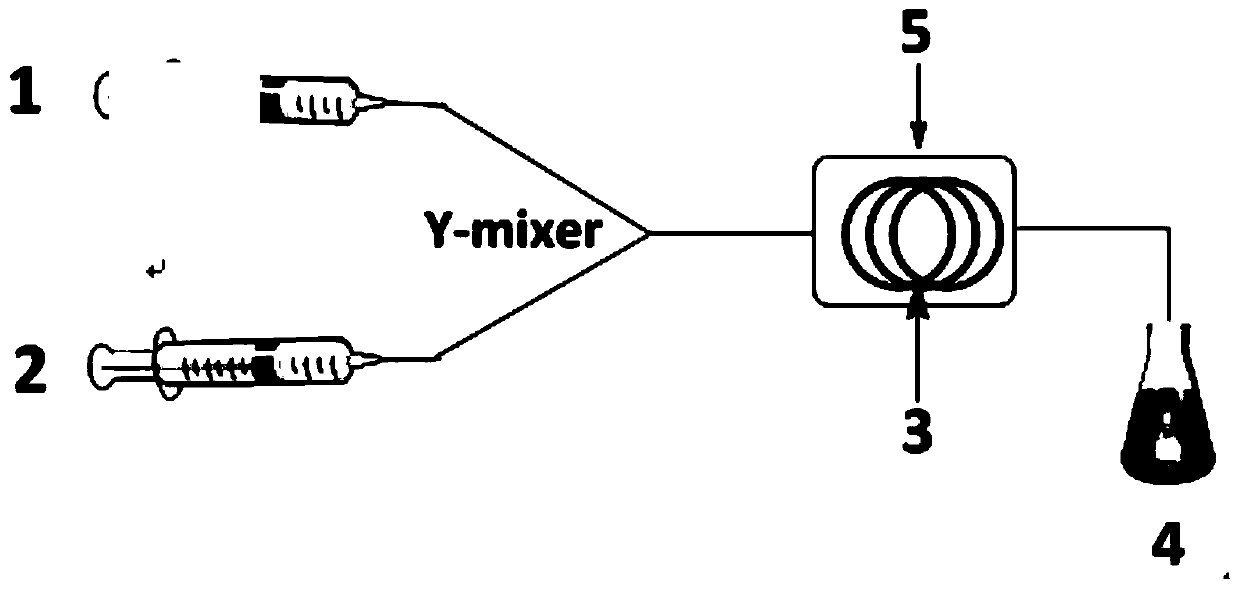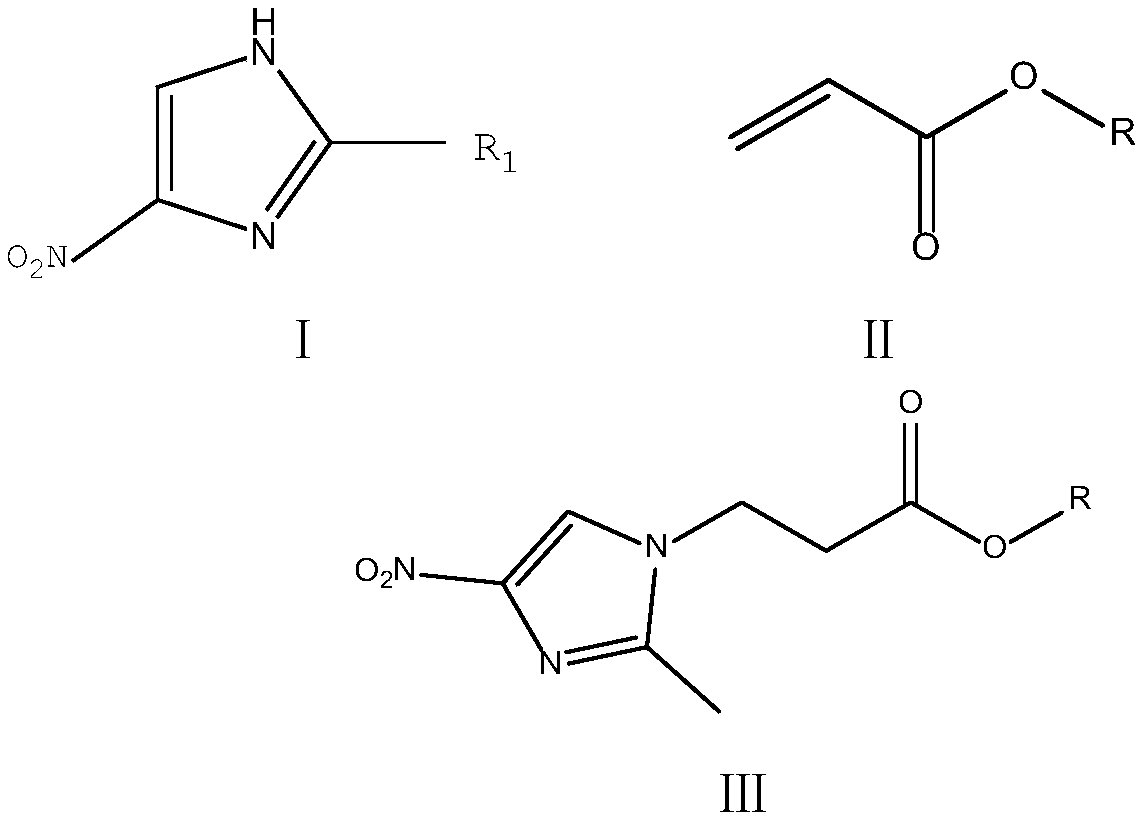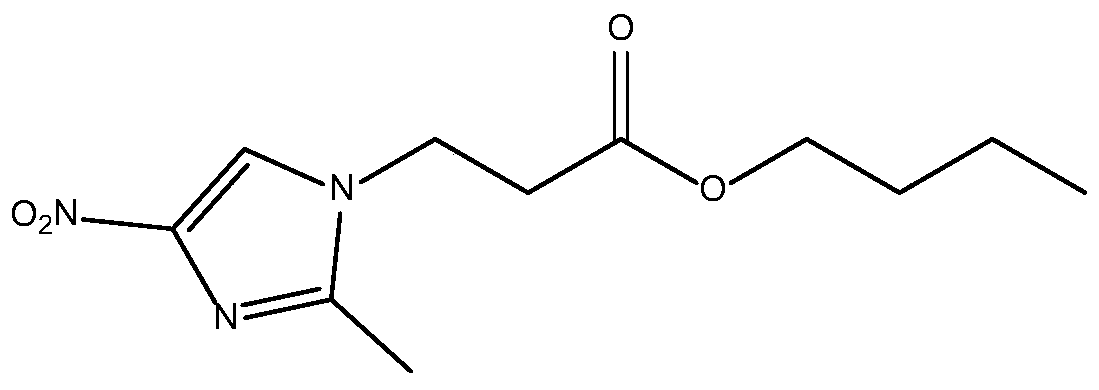On-line nitroimidazole derivative synthesis method by adopting enzymatic means
A technology for nitroimidazoles and derivatives, which is applied in the field of on-line enzymatic synthesis of nitroimidazole derivatives, can solve the problems of unsatisfactory conversion rate of specific substrate reaction, high price, long reaction time and the like, and shorten the reaction time. effect of time, reduced reaction costs, high conversion and selectivity
- Summary
- Abstract
- Description
- Claims
- Application Information
AI Technical Summary
Problems solved by technology
Method used
Image
Examples
Embodiment 1
[0031] Embodiment 1: 3-(2-methyl-4-nitroimidazole) butyl propionate
[0032]
[0033] device reference figure 1 : Dissolve 2-methyl-4-nitroimidazole (1.0mmol) in 10mL DMSO, and butyl acrylate (4.0mmol) in 10mL DMSO, and then put them in 10mL syringes for use. 0.87g of lipase LipozymeRM IM was evenly filled in the reaction channel, driven by the PHD2000 syringe pump, the two reaction solutions were separated at 7.3 μL min -1 The flow rate enters the reaction channel through the "Y" joint for reaction, and the temperature of the reactor is controlled at 45°C by a water bath thermostat. The reaction solution flows continuously in the reaction channel for 35 minutes, and the reaction results are tracked and detected by thin-layer chromatography (TLC).
[0034] The reaction solution was collected online by a product collector, the solvent was distilled off under reduced pressure, and the column was wet-packed with 200-300 mesh silica gel. The elution reagent was petroleum ether...
Embodiment 2-4
[0038] Change the temperature of the microfluidic channel reactor, others are the same as in Example 1, and the reaction results are as shown in Table 1:
[0039] Table 1: Effect of Temperature on Reaction
[0040]
[0041] The results in Table 1 show that when the flow rate is 7.3 μL min -1 , when the reaction time is 35min, the conversion rate increases significantly with the increase of the reaction temperature. When the reaction temperature reaches 45°C, the conversion rate of the reaction is the best. If the temperature continues to rise at this time, the enzyme activity will decrease. , thereby causing the conversion rate and selectivity of reaction to reduce to some extent, so the optimal reaction temperature of 3-(2-methyl-4-nitroimidazole) butyl propionate in the microfluidic microchannel reactor of the present invention is 45°C.
Embodiment 5-8
[0043] Based on the amount of 2-methyl-4-nitroimidazole, change the ratio of the amount of substrate substance of 2-methyl-4-nitroimidazole and butyl acrylate in the microfluidic microchannel reactor, and control the temperature 45 DEG C, other with embodiment 1, the result is as shown in table 2:
[0044] Table 2: Effect of 2-methyl-4-nitroimidazole and butyl acrylate substrate molar ratio on reaction
[0045] Example
[0046] The results in Table 2 show that when the flow rate is 7.3 μL min -1 , the reaction time is 35min, and the reaction temperature is 45°C. The reactor uses DMSO as the organic solvent. With the increase of the reactant butyl acrylate, the conversion rate of the reaction also increases. When the ratio of the substrate to 2-methyl- When the ratio of 4-nitroimidazole and butyl acrylate is 1:4, the conversion rate of the reaction is optimal, so the ratio of the amount of the optimal substrate substance in the microfluidic microchannel reactor in th...
PUM
 Login to View More
Login to View More Abstract
Description
Claims
Application Information
 Login to View More
Login to View More - R&D
- Intellectual Property
- Life Sciences
- Materials
- Tech Scout
- Unparalleled Data Quality
- Higher Quality Content
- 60% Fewer Hallucinations
Browse by: Latest US Patents, China's latest patents, Technical Efficacy Thesaurus, Application Domain, Technology Topic, Popular Technical Reports.
© 2025 PatSnap. All rights reserved.Legal|Privacy policy|Modern Slavery Act Transparency Statement|Sitemap|About US| Contact US: help@patsnap.com



